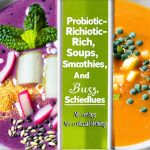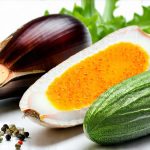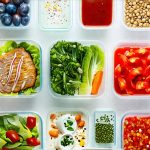The quest for gut health often leads us down paths filled with fermented foods and probiotic supplements, but many overlook a simple, delicious strategy: incorporating probiotic-rich side dishes into everyday meals. It’s not just about adding probiotics; it’s about doing so in a way that minimizes digestive discomfort – specifically, the dreaded gas! Many people experience bloating and flatulence when increasing their intake of fermented foods due to rapid shifts in gut bacteria or sensitivities to certain ingredients. This article explores how to build side dishes brimming with beneficial bacteria without triggering unwanted digestive distress, focusing on preparation methods, ingredient pairings, and portion control for optimal gut health and comfort.
Traditional probiotic sources like sauerkraut and kimchi are fantastic, but their strong flavors aren’t always welcome in every meal. Furthermore, the fermentation process can sometimes create compounds that contribute to gas production in sensitive individuals. The key is to diversify your probiotic intake with milder options and thoughtfully prepared side dishes. We’ll focus on building a repertoire of sides using ingredients like yogurt, kefir, lightly fermented vegetables (think quick pickles), and even specific types of fruits, all while prioritizing digestibility through mindful preparation and careful ingredient combinations. This isn’t about restriction; it’s about expanding your probiotic horizons in a way that supports—rather than sabotages—your digestive wellbeing. For those struggling to identify triggers, understanding recognizing food intolerances can be a valuable first step.
Cultivating Comfort: Gentle Probiotic Sources
The foundation of gas-free probiotic side dishes lies in selecting sources that are naturally gentler on the gut. Full-strength, long-fermented products can be incredibly beneficial, but starting with milder options allows your microbiome to adapt gradually. Greek yogurt is an excellent example. Its thicker texture and lower lactose content often make it easier to digest than regular yogurt, while still providing a healthy dose of probiotics. Similarly, kefir – a fermented milk drink – offers a wider range of probiotic strains and can be even more easily tolerated by some individuals. When choosing these dairy options, opt for plain, unsweetened varieties to avoid added sugars that can feed unwanted bacteria in the gut. If you are concerned about GERD, consider gerd-safe snacks as well.
Beyond dairy, lightly fermented vegetables offer a fantastic alternative. Quick pickles—cucumbers, carrots, or radishes briefly submerged in a brine of water, salt, and often vinegar—provide a subtle probiotic boost without the strong flavor (and potential gas-producing compounds) of traditional sauerkraut. The fermentation time is short enough that it doesn’t overwhelm the digestive system, making them a perfect addition to salads or as a crunchy side. Finally, don’t underestimate the power of fruits! While not all fruits are probiotic-rich, some varieties – particularly those with edible peels—contain naturally occurring bacteria and prebiotic fibers that support gut health.
It’s also crucial to consider how these ingredients are prepared. Raw dairy products may be more difficult to digest for some; lightly cooking or fermenting can aid in breaking down lactose. Similarly, while raw vegetables are nutritious, gently steaming or sautéing them can reduce their fiber content and make them easier on the gut. Remember that individual tolerance varies greatly, so paying attention to your body’s signals is key. If you’re aiming for a balanced diet with less bloating, exploring fiber-rich dinners can be helpful too.
Beyond Fermentation: Prebiotic Power & Digestive Support
Probiotics thrive when they have something to eat – that’s where prebiotics come in. These are types of fiber that act as food for beneficial gut bacteria, helping them flourish and improve overall digestive function. Incorporating prebiotic-rich ingredients into your side dishes can amplify the benefits of probiotics and reduce gas production by fostering a balanced microbiome. Excellent sources include garlic, onions, leeks, asparagus, bananas (slightly green ones are best), and oats.
However, even prebiotics can cause gas in sensitive individuals if consumed in large quantities. The trick is to balance them with easily digestible ingredients and prepare them thoughtfully. For example, sautéing onions thoroughly reduces their fructan content – a type of prebiotic fiber that can trigger bloating in some people. Combining prebiotics with probiotics creates a synergistic effect called synbiotic nutrition, which maximizes gut health benefits. A side dish featuring lightly fermented carrots (probiotic) alongside a small amount of sautéed onion and garlic (prebiotic) is a prime example. Learning about prebiotic fiber sources can help you make informed choices.
Finally, don’t underestimate the power of mindful eating habits. Eating slowly, chewing thoroughly, and avoiding distractions during meals all contribute to better digestion and reduced gas production. Adding digestive aids like ginger or peppermint tea can also help soothe the gut and promote comfortable digestion.
Minimizing Gas with Preparation Techniques
Preparation plays a huge role in digestibility. Here are some techniques to reduce gas-producing compounds:
- Soaking legumes: If you include beans or lentils, soaking them overnight and discarding the water significantly reduces oligosaccharides – sugars that can cause flatulence.
- Gentle cooking methods: Steaming, sautéing, or roasting vegetables is generally easier on the gut than frying or boiling, which can increase fiber density and make them harder to digest.
- Spice it right (but carefully): While spices like cumin and coriander can aid digestion, excessive amounts of chili powder or other strong spices may irritate sensitive stomachs. Start small and assess your tolerance.
Portion Control & Gradual Introduction
Introducing probiotics too quickly can disrupt the gut microbiome and lead to temporary bloating and gas. Start with small portions – a few tablespoons of yogurt or kefir, or a small serving of quick pickles – and gradually increase your intake over time as your body adjusts. Listen to your body’s signals; if you experience discomfort, reduce the portion size or take a break from probiotic-rich foods for a few days.
It’s also important to diversify your sources. Relying on just one type of fermented food can limit the diversity of probiotics in your gut. Experiment with different options – yogurt, kefir, quick pickles, lightly fermented vegetables – and find what works best for you. Remember that everyone’s digestive system is unique, so there’s no one-size-fits-all approach. Consider prebiotic-rich foods to support this process.
Building a Gut-Friendly Side Dish Repertoire
Here are some ideas to get you started:
- Yogurt with Berries & Oats: Plain Greek yogurt topped with a handful of blueberries (a source of prebiotic fiber) and a sprinkle of rolled oats provides a gentle probiotic boost.
- Quick Pickled Radishes with Cucumber Salad: Lightly fermented radishes add a tangy crunch to a refreshing cucumber salad, providing both probiotics and prebiotics.
- Kefir-Marinated Carrot & Ginger Salad: Marinating grated carrots in kefir with a touch of ginger creates a flavorful side dish that’s easy to digest and supports gut health.
Ultimately, incorporating probiotic-rich side dishes into your diet shouldn’t be about deprivation or discomfort; it should be about nurturing your gut microbiome in a way that feels good and supports overall wellbeing. By choosing gentle sources, preparing foods thoughtfully, and paying attention to your body’s signals, you can unlock the benefits of probiotics without the unwanted gas! If you struggle with reflux, consider dinner recipes that won’t worsen symptoms. For those seeking lighter options, exploring stir-fry combinations can also be a great solution.

















